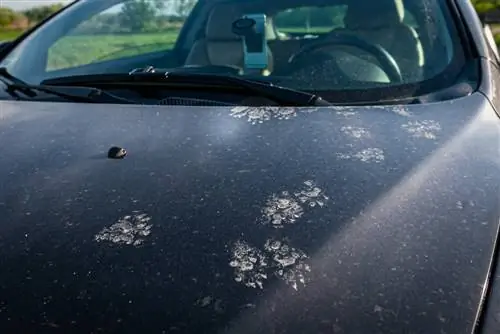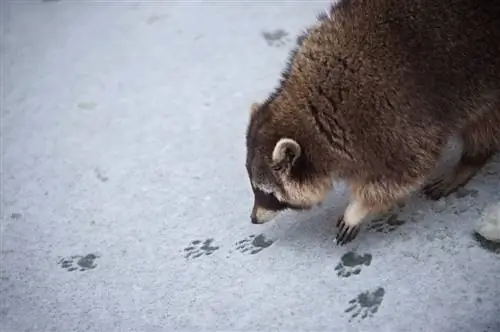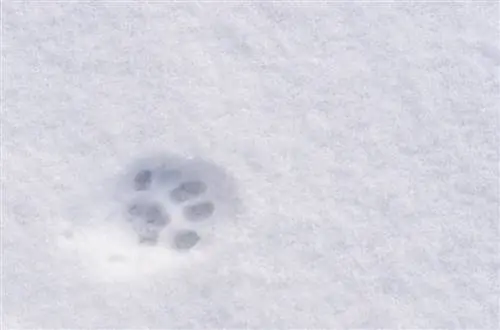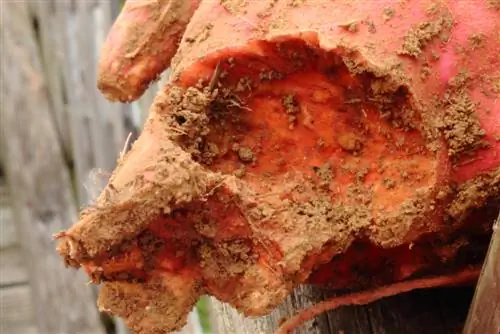- Author admin [email protected].
- Public 2023-12-16 16:46.
- Last modified 2025-01-23 11:22.
Marten tracks are very similar to those of cats. But with a good eye and a little analysis, they can definitely be distinguished from other animal tracks. In the following, learn about the characteristics of marten tracks and how to make them visible.
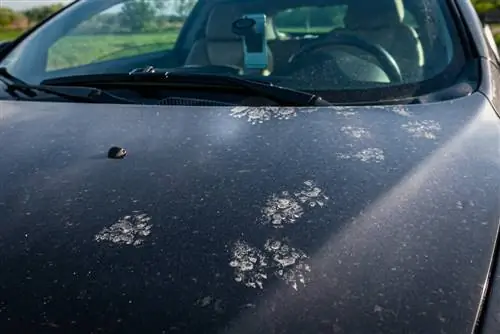
How do I recognize marten tracks?
Marten tracks are usually 4.5 cm long, 3.5 cm wide and have five toe prints plus claws. In contrast, cat tracks are shorter and rounder without claw marks. Marten traces can be made visible using flour, lime or fine sand.
What do marten tracks look like?
Martens and cats are roughly the same size, which is why their paw prints are also a similar size. However, marten prints are slightly more elongated because the distance between the pads and toes is slightly larger. This creates the overall impression of an oval print, whereas that of a cat appears more round. For the same reason, the marten's print is about 4.5cm long, slightly longer than that of a cat, which is only about 3.5cm long. In addition, only four toes can be seen in cats, whereas in martens there are often five.
Summary: Characteristics of a marten track
- approx. 4.5cm long and 3.5cm wide
- Crescent-shaped bale
- 5, sometimes only 4 visible toes radiating out from the ball of the foot
- With a fine marten paw print, claw marks can be seen in front of all five toes
Here is a video that clearly shows the characteristics of marten tracks:

Running behavior in martens and cats
It's not just the prints themselves that differ from animal to animal, the way they move also allows conclusions to be drawn as to whether the tracks are marten or cat tracks: While cats usually leave beautifully symmetrical tracks, Since the distances between the prints are all similar, martens usually leave two prints very close together, while the next two are further away. However, if the marten has only taken a leisurely walk, the course of the tracks is similar to that of cats.
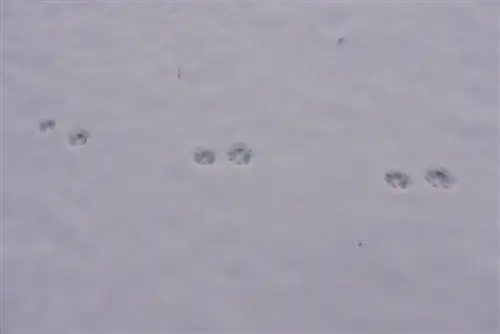
If the marten was moving quickly, its front and back paw prints are close together
Distinguish marten tracks from other animal tracks
Animal tracks are not easy to distinguish, especially since they are often not clearly visible. In the following table we have summarized the most common animal tracks with their size and characteristics for you.
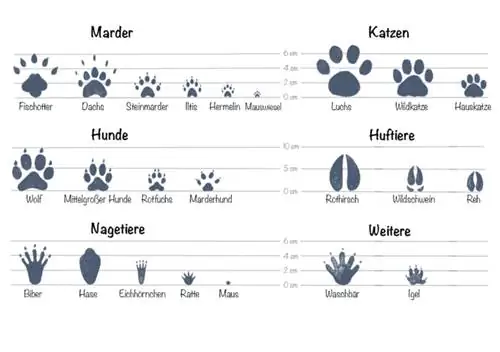
| Marten | Cat | Dog | Raccoon | Fox | Badger | |
|---|---|---|---|---|---|---|
| Imprint Size | 4, 5cm long, 3.5cm wide | 3, 5cm long, 3cm wide | Depending on the species | approx. 7cm, front paw smaller | approx. 5cm long, approx. 3cm wide | Hin paw up to 7cm long, front paw slightly smaller |
| Shape of the bale | Crescent shaped | Crescent-shaped or rhombus-shaped | Triangular | a single print like that of a child | Triangular, similar in size to toe pad print | Forepaw crescent-shaped, hind paw long, almost like a human footprint |
| Number of toes | 4 or 5 | 4 | 4 | 5 | 4 | 5 |
| clawprint | Yes | No | Yes | Yes | Yes | Yes |
| Confusion | With cat | With marten | With Fox | Possibly. with badger | With dog tracks, fox prints are narrower and front toes point slightly inwards | Possibly. with raccoon |
Make marten tracks visible
The tracks are not always easy to see. So if you want to be sure that there really is a marten on your roof, you can try to make its tracks visible first. To do this, sprinkle odorless, dry, fine substances in those places where you suspect a marten is passing through. The following are eligible:
- Flour
- fine sand
- Lime
- finely ground coal
Tip
Do not use anything that has been flavored, such as baby powder.
Marten tracks in the snow
Recognizing and determining animal tracks in the snow is particularly complicated because the prints are rather vague, especially in fine snow. Here you can e.g. B. pay attention to the gait. As I said, martens usually have two paw prints close together. However, if the marten runs slowly, its gait can be very similar to that of a cat. You can also pay attention to the rough shape of the track here:
- Marten tracks are more oval compared to cat tracks.
- Claw prints may be visible on the pointed edges.
- Hind and front paws are almost identical, unlike, for example, the badger or raccoon, where the front paw is significantly smaller than the hind paw.
Scratch marks from martens

Martens also leave traces with their claws and teeth
Martens not only leave paw prints but also completely different traces, namely scratch marks. In order to get to their destination, martens claw strongly and to gain access, they sometimes scratch open an opening.
Where do martens leave scratch marks?
Martens are good climbers and can also climb vertical obstacles using their claws. They leave scratch marks, e.g. on:
- A gutter
- A house wall with projections
- trees
- Roof shingles
- Openings
- Roof beams
What do these scratch marks look like?
Have you ever left a mark in soft wood with a nail? This is what scratch marks look like, except that martens naturally have sharper claws and their scratch marks are therefore a little narrower than ours and can also penetrate deeper into harder materials. Since martens have five claws on each paw, they usually leave behind a sea of scratch marks, very similar to cats.
Damage to insulation
Martens love insulation! It is nice and warm and can be used wonderfully for building nests. Therefore, martens in the wall or in the car often cause damage to the insulation. They don't just leave scratch and bite marks; What is noticeable is that some of the insulation that the marten takes with it when building a nest is missing.
Excursus
Marten nest building
In February, the pregnant female marten starts building a nest in order to give birth to her young there at the beginning of March. The location she chooses is a dark, dry place such as the attic, a barn or even a loophole in the wall. Martens prefer hiding places higher up, which is why the cellar is rarely inhabited. Pine martens raise their young in tree hollows or abandoned bird nests. The nests are padded with leaves, straw, insulating material and other soft materials.
Marten bite marks

To expand openings, martens scratch and bite them
Martens are known to like to attack hoses and cables in the engine compartment, but with a bit of bad luck, a cable in the false ceiling can also take hold.
The reasons for biting have not been conclusively clarified. In the engine compartment, martens (almost always the second marten) probably cause damage out of rivalry; in the false ceiling or in the attic, pure curiosity can be the reason for a bite. In most cases, however, the cables and hoses are not bitten through cleanly, but rather just nibbled on, which is the reason why the damage is often not discovered straight away.
Frequently asked questions
How can I distinguish marten tracks from cat tracks?
Marten tracks usually have five toe prints, while cats only have four. In addition, cat prints tend to be round (the same width as they are long), while marten prints are more elongated. The best identifying feature are the claw prints, which are completely missing from cat tracks.
There are marten tracks on my car, what should I do?
While the first marten usually does not cause any damage when it visits the engine compartment, the second one bites wildly when the rival smells. This danger is particularly present during the mating season in summer. If it's summer, you should check your car for possible marten damage or take it to the workshop if damage is suspected.
How do I make marten tracks visible?
Sprinkle flour, lime or fine sand where you suspect a marten might be passing through. The marten will leave beautiful, clear tracks when entering.

